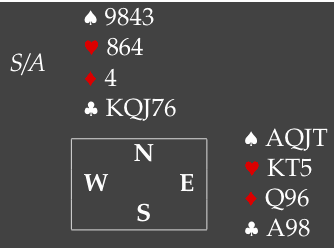 Next Saturday, a couple of friends will be going up for their tournament director’s exam. It is actually quite hard to become a TD here. They are thus studying hard and asking questions to the experienced TD’s they known. Earlier this week, I ran across this hand that could be a good question for the TD exam. Here it is, take it as a bridge problem first.
Next Saturday, a couple of friends will be going up for their tournament director’s exam. It is actually quite hard to become a TD here. They are thus studying hard and asking questions to the experienced TD’s they known. Earlier this week, I ran across this hand that could be a good question for the TD exam. Here it is, take it as a bridge problem first.
 You are defending 1NT after the auction 1♦ from south, 1♠ by north, 1NT by south, all pass. The opponents play standard, so south has shown 12-14 balanced with 4+♦. Matchpoint pairs at Interbridge. Partner leads the ♠5, ♠3, you play the ♠A (the ♠T is probably better, though it hardly matters for the outcome), ♠6. In trick 2, you return the ♠Q for declarer’s king. Declarer plays the ♣5, ♣3, ♣J and you duck, of course. In trick 4, the ♥4 is played from the dummy, ♥5, ♥Q, ♥2. Declarer plays a second club: ♣2, ♣T, ♣Q. Unfortunately, you are playing in a partnership where you don’t use count signals. Decision time, you take a moment to analyze the play so far and consider your options:
You are defending 1NT after the auction 1♦ from south, 1♠ by north, 1NT by south, all pass. The opponents play standard, so south has shown 12-14 balanced with 4+♦. Matchpoint pairs at Interbridge. Partner leads the ♠5, ♠3, you play the ♠A (the ♠T is probably better, though it hardly matters for the outcome), ♠6. In trick 2, you return the ♠Q for declarer’s king. Declarer plays the ♣5, ♣3, ♣J and you duck, of course. In trick 4, the ♥4 is played from the dummy, ♥5, ♥Q, ♥2. Declarer plays a second club: ♣2, ♣T, ♣Q. Unfortunately, you are playing in a partnership where you don’t use count signals. Decision time, you take a moment to analyze the play so far and consider your options:
 Case 1. You decide to duck the club. Declarer plays a second heart from the dummy: ♥6, ♥T, ♥J, ♥7, followed by the ♥A and declarer claims 8 tricks, his full hand is shown on the left. Not a success, winning the ♣A and returning a diamond would have defeated the contract.
Case 1. You decide to duck the club. Declarer plays a second heart from the dummy: ♥6, ♥T, ♥J, ♥7, followed by the ♥A and declarer claims 8 tricks, his full hand is shown on the left. Not a success, winning the ♣A and returning a diamond would have defeated the contract.
 Case 2. You win the club and cash the remaining spades. Declarer shows his hand and claims 8 tricks, as the club suit is now good. His hand is shown on the left. Again, not a success, ducking the ♣A would have cut communications and led to down 1.
Case 2. You win the club and cash the remaining spades. Declarer shows his hand and claims 8 tricks, as the club suit is now good. His hand is shown on the left. Again, not a success, ducking the ♣A would have cut communications and led to down 1.
So, which card do you play?
Without count signals it is a guess. It is probably slightly better to duck the second club, as declarer will go down if he has the ♦J instead if the ♥J, but it is nothing better than a best guess. Obviously, good pairs won’t have this problem, as they have discussed how to follow to the club tricks but that is outside the scope of this blog.
I’m not going to give you the solution just yet, instead we go back to trick 6. Declarer plays the ♣2, west thinks for a while then contributes the ♣T , ♣Q and you play the ♣A. After the hand is over, declarer calls the TD. Klaas, Christa and everybody else who wants to be a TD, your turn.
Obviously, it has now become a lot easier for east to do the right thing on the second round of clubs. With only the ♣T3, west has nothing to think about on the second round of clubs. With ♣T43, he has 2 cards that he can play and a decision to make. I admit that I’m not sure what he was thinking about or why he decided to play the ♣T anyway, but he did show that he had an alternative to the ♣T.
 Obviously, all this rules out case 2 and it becomes trivial for east to win the ♣A. Equally obvious, this is not allowed, Law 16 states that if the break in tempo suggests that one action will work out better than the alternative, the former action may not be selected. In practice, declarer had this hand and ended up down 2 after east won the ♣A. Ducking the second club does still leads to down 1, but as can be expected, there is a huge matchpoints difference, about 2/3 of a top, between 1NT, down 1 for -100 and down 2 for -200.
Obviously, all this rules out case 2 and it becomes trivial for east to win the ♣A. Equally obvious, this is not allowed, Law 16 states that if the break in tempo suggests that one action will work out better than the alternative, the former action may not be selected. In practice, declarer had this hand and ended up down 2 after east won the ♣A. Ducking the second club does still leads to down 1, but as can be expected, there is a huge matchpoints difference, about 2/3 of a top, between 1NT, down 1 for -100 and down 2 for -200.
Time to bring out the firing squad and shoot the offenders at dawn? O no, we’re not that drastic, we only adjust from 1NT, down 2 to 1NT, down 1.
